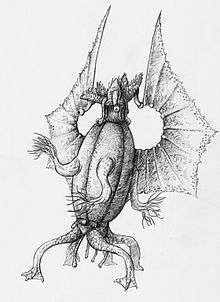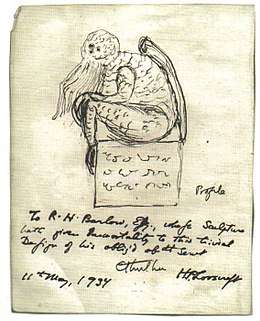Elder Thing
The Elder Things (also known as the Old Ones[1] and Elder Ones[2]) are fictional extraterrestrials in the Cthulhu Mythos. The beings first appeared in H. P. Lovecraft's novella, At the Mountains of Madness (published in 1936, but written in 1931), and later appeared, although not named, in the short story "The Dreams in the Witch-House" (1933). Additional references to the Elder Things appear in Lovecraft's short story "The Shadow Out of Time" (1936).[3]
| Elder Thing | |
|---|---|
 A generic Elder Thing specimen. | |
| First appearance | At the Mountains of Madness |
| Last appearance | "The Shadow Out of Time" |
| Created by | H. P. Lovecraft |
| In-universe information | |
| Type | Extraterrestrial life form |
Summary
Description of a partial headless body:
Six feet end to end, three and five-tenths feet central diameter, tapering to one foot at each end. Like a barrel with five bulging ridges in place of staves. Lateral breakages, as of thinnish stalks, are at equator in middle of these ridges. In furrows between ridges are curious growths—combs or wings that fold up and spread out like fans ... which gives almost seven-foot wing spread. Arrangement reminds one of certain monsters of primal myth, especially fabled Elder Things in the Necronomicon.
- —H. P. Lovecraft, At the Mountains of Madness
In the Mythos canon, the Elder Things were the first extraterrestrial species to come to the Earth, colonizing the planet about one billion years ago.[4] They stood roughly eight feet tall and had the appearance of a huge, oval-shaped barrel with starfish-like appendages at both ends. The top appendage was a head adorned with five eyes, five eating tubes, and a set of cilia for "seeing" without light. The bottom appendage was five-limbed and was used for walking and other forms of locomotion. The beings also had five leathery, fan-like retractable wings and five sets of branching tentacles that sprouted from their torsos. Both their tentacles and the slits housing their folded wings were spaced at regular intervals about their bodies.
Lovecraft described the Elder Things as vegetable-like or echinoderm-like in shape, having radial symmetry instead of the bilateral symmetry of bipeds. They also differed in that they had a five-lobed brain. The Elder Things exhibited vegetable as well as animal characteristics, and in terms of reproduction, multiplied using spores, although they discouraged increasing their numbers except when colonizing new regions. Though they could make use of both organic and inorganic substances, the Elder Things were carnivorous by preference. They were also amphibious.
The bodies of the Elder Things were incredibly tough, capable of withstanding the pressures of the deepest ocean. Few died except by accident or violence. The beings were also capable of hibernating for vast epochs of time. Nonetheless, unlike many other beings of the Mythos, the Elder Things were made of normal, terrestrial matter.
Technology
The technology that the Elder Things possessed was not described at length, but was described as being extremely advanced. They are also revealed in At the Mountains of Madness as being the creators of a servitor race, the shoggoths.
Society
Because they reproduced through spores, there was little biological basis for families to form, and were thus grouped together with others with whom they would get along. Elderian "families" lived in large dwellings, where furniture and other decoration was placed in the center of the rooms, to leave the walls open for murals.
In furnishing their homes they kept everything in the center of the huge rooms, leaving all the wall spaces free for decorative treatment. Lighting, in the case of the land inhabitants, was accomplished by a device probably electro-chemical in nature. Both on land and under water they used curious tables, chairs and couches like cylindrical frames – for they rested and slept upright with folded-down tentacles – and racks for hinged sets of dotted surfaces forming their books.
Government was evidently complex and probably socialistic, though no certainties in this regard could be deduced from the sculptures we saw. There was extensive commerce, both local and between different cities – certain small, flat counters, five-pointed and inscribed, serving as money. Probably the smaller of the various greenish soapstones found by our expedition were pieces of such currency. Though the culture was mainly urban, some agriculture and much stock raising existed. Mining and a limited amount of manufacturing were also practiced. Travel was very frequent, but permanent migration seemed relatively rare except for the vast colonizing movements by which the race expanded. For personal locomotion no external aid was used, since in land, air, and water movement alike the Old Ones seemed to possess excessively vast capacities for speed. Loads, however, were drawn by beasts of burden – Shoggoths under the sea, and a curious variety of primitive vertebrates in the later years of land existence.
—H.P. Lovecraft, At the Mountains of Madness
In "The Dreams in the Witch-House," the central character is sent through a dimensional portal to a planet in a triple star system (with a yellow, red, and blue star) located "between Hydra and Argo Navis", and populated by Elder Things.
History
On Earth, the Elder Things built huge cities, both underwater and on dry land. They may be responsible for the appearance of the first life-forms on Earth, including the entity known as Ubbo-Sathla (although sources differ in this regard). They created the shoggoths to be their all-purpose slave race. Eventually, however, the shoggoths rebelled—an event that hastened the decline and ultimate collapse of their civilization. Although the Elder Things managed to initially subdue the shoggoths after their attempted rebellion, the shoggoths continued to improve physiologically, increasing in intelligence and developing the capacity to live on land.
The Elder Things are known to have warred against the star-spawn of Cthulhu, the Great Race of Yith, and the Mi-go. Despite these conflicts, it was the gradual cooling of the planet during the last ice age that spelled their doom. Retreating to their undersea cities deep in the ocean, they would thereafter have no further dealings with the outer world. Their last surface city, located on a high plateau in the Antarctic, remains frozen in ice. The ruins of this city were discovered in 1931 by two members of an Antarctic expedition from Miskatonic University.
The last known and most significant undersea city is located directly beneath the Elder Things' ultimate surface city in the Antarctic, and was apparently overrun by the shoggoths. Four of the eight Elder Things (still alive after millions of years) unearthed by other members of the Miskatonic expedition were described in the story At the Mountains of Madness as being survivors from an early age of the species' civilization. They were killed by a shoggoth while attempting to find a means to enter the subterranean ocean in the Antarctic, apparently unaware of the city's collapse.
Not named, but implied by description, the Elder Things appeared in "The Dreams in the Witch House".
The Elder Things were also involved in Brian Lumley's short story "In the Vaults Beneath" published in The Caller of the Black (Arkham House), 1971.
Notes
- The term "Old Ones" is ambiguous in the Cthulhu Mythos and can also refer to the Great Old Ones, a separate group of beings described as being enemies of the Elder Things in At the Mountains of Madness.
- In At the Mountains of Madness, Professor Lake dubs the specimens he discovers "Elder Ones" in reference to the Elder Things of the Necronomicon, unaware that they are actually the same beings.
- Joshi, S.T.; Schultz, David E. (2004). An H.P. Lovecraft Encyclopedia. Hippocampus Press. pp. 233–236. ISBN 978-0974878911.
- Harms, "Appendix D: Timeline of the Cthulhu Mythos", The Encyclopedia Cthulhiana, p. 384.
References
- Harms, Daniel (1998). "Elder Things". The Encyclopedia Cthulhiana (2nd ed.). Oakland, CA: Chaosium. pp. 99–100. ISBN 1-56882-119-0.
- Lovecraft, Howard P. (2005) [1936]. "At the Mountains of Madness". At the Mountains of Madness: The Definitive Edition. New York, NY: The Modern Library. ISBN 0-8129-7441-7. Introduction by China Miéville.
